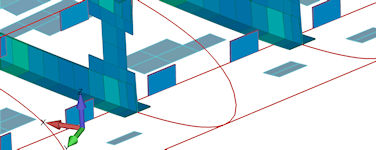Meaningful Analysis Requires Control


How important is accuracy to simulation?
It depends.
In the past, that sort of answer would be immediately dismissed. The purpose of simulation has traditionally been to validate the performance of a design before a company invests money and time into a prototype. It was a means to mitigating the risk that they would have to invest such money and time again if that prototype failed.
Today, however, the required degree of accuracy for a simulation depends on how it is being used. Early in design, when analysis is being used to assess many different concepts and ideas, speed is favored over accuracy. Switch to late in design, when analysis is used to validate performance, accuracy is the tip-top priority. So how important is accuracy to simulation today?
Well, it depends. Rightfully so.
How does one specify the accuracy of a simulation? Well, there is a slight misnomer there. In reality, it is important to have a simulation accurately predict the performance of a design in its operating conditions. So, more to the point, the right question becomes: how does one ensure a simulation accurately predict how a design will perform in its operating environment?
In that case, the answer is control.
Control over Geometry
One key to specifying the accuracy of a simulation is control over geometry.
The development of a 3D model in a mechanical CAD application has long been a precursor to analysis. Such models are needed for a variety of purposes such as authoring engineering documentation, design of tooling, development of service instructions and much more. Furthermore, such models are highly precise.
When it comes to developing a simulation model, the geometry of a 3D model is very useful. It can be reused as the foundation of an analysis. The trick, however, is that such designs often have too much detail. They include holes, and fasteners, and small chamfers. Many such details have no effect on the desired measurement from the simulation. Yet, including such details can dramatically increase the amount of time it takes to solve an analysis. As a result, such details can be removed without affecting the accuracy of the simulation.
The means of removing such geometric detail, however, is not always easy. Parametric modeling provides few controls to modify models from other CAD applications. Direct modeling, however, offers a means to change geometry without any underlying features or parameters.
Control over Setup
Another key to specifying the accuracy of a simulation is control over the analysis setup.
One of the most important factors of the analysis setup is the finite element mesh. As the mesh of a simulation model becomes more dense, there are more measurement points. In turn, this means that the actual peak physics phenomena are increasingly likely to be picked up by the mesh. There are many different ways to control such a mesh, including manually creating elements, relying on automated meshing, starting out a mesh with seed elements, and even interactive meshing. Each of these methods are needed for different scenarios.
Another factor of analysis setup is defining loads and boundary conditions. Together, these two aspects of the simulation represent the operating conditions the design will experience in the real world. It is important to be able to capture the complexity of the real world environment as well as the multitude of those cases.
The ability to control the mesh and setup of the simulation will vary dramatically from solution to solution. In order to accurately predict the response of a design in its operating environment, it is crucial to control both in fine detail.
Control over the Solve
The last key to specifying the accuracy of a simulation is control over the solver and its parameters.
Once an analysis is set up, the last part may seem simple. All you have to do is send the analysis to a solver and look at results. However, there is great detail that is often hidden from users. First, an analysis can be calculated using a wide variety of solvers, each of which has advantages and disadvantages. Second, solvers often offer a number of different methods to solve the same kind of analysis, again each with their advantages and disadvantages. Lastly, each method within each solver have parameters that can be tuned or tweaked to adjust calculations. All of these details affect the accuracy of a simulation.
The ability to make these choices and modify these variables will differ dramatically from simulation solution to solution. If highly accurate analyses are important to an organization, then they must include tools that offer this kind of control.
Recap
- The degree of accuracy needed for analyses is dependent on how and when the simulation’s results are being used in the design cycle.
- Control over a simulation model’s geometry, setup, and solve heavily influences how accurately an analysis will reflect the design’s response to its operating environment.
- Modifications to a simulation model’s geometry are important to remove unnecessary details that increase solve times. Direct modeling is a crucial enabler in this regard.
- Finely controlling the simulation model’s finite element mesh, loads, and boundary conditions directly affect accuracy as well.
- Selecting the solver, the solver method, and its parameters is another set of controls that directly impact accuracy.
Folks, that’s my view on the relationship between accuracy and control. Looking forward to hearing your perspective in the comments.
Siemens PLM provides a range of capabilities that directly address the multi-CAD reality of modern simulation. For more details on how FEMAP addresses these needs, download our complimentary eBook.


